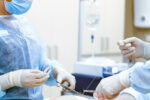Facts about this surgery
- Loose skin on the stomach and possible laxity of the abdominal wall are typically seen after pregnancy or major weight loss
- In so-called abdominoplasty, the excess skin is removed downwards on the abdomen and the abdominal muscles are possibly tightened
- You may risk changing the sense of touch on the skin, very visible scars, infection, heavy bleeding and fluid accumulation in the treated area
- The more extensive the operation, the greater the risk
Surgery for loose stomach skin
There are several types of surgery for loose abdominal skin:
- The classic abdominoplasty, where a long incision is made over the pubic hair, and skin and fat are loosened right up to the lower edge of the ribs. The operation can, in the case of a greater excess of skin in the vertical plane, be extended with a scar in the midline from the transverse scar downwards and up to the diaphragm. The procedure is called Fleur de Lis after a French lily
- The mini-abdominoplasty, where skin and fat are only loosened up to the navel and the excess tissue is removed
The intervention is carried out both privately and publicly. In public settings, the degree of sagging stomach must be pronounced and give rise to health problems such as eczema of the skin. In addition, height and weight requirements must be met in order to be offered the operation.
What is the purpose?
The purpose is to tighten the abdominal skin by removing excess skin and subcutaneous fat, which cannot be trained or slimmed down. Births and major weight loss are common causes of loose skin on the abdomen. With minor weight loss, the skin often has the ability to contract again.
Abdominoplasty is a tightening and removal of excess skin on the abdomen, but is not a slimming method. If you are very overweight, you should lose weight before the operation, as significant excess weight gives a worse result and an increased risk of complications during the operation.
How does the operation take place?
Mini abdominoplasty
In mini-abdominoplasty, the plastic surgeon makes a cross section along the lower part of the abdomen. The incision is slightly U-shaped and is made just above the pubic hair, almost from hip to hip. The skin on the stomach is loosened from the abdominal wall together with fat up to the level of the navel.
The excess skin and fat is cut away. The remaining skin is tightened and stitched in place. There is usually no scar around the navel with this operation.
Mini abdominoplasty is often performed in local anaesthetic.
Classic abdominoplasty
With the classic abdominoplasty, the plastic surgeon makes the same skin incision as with mini-abdominoplasty, perhaps a little longer. In addition, an incision is also made around the navel to free it from the surrounding tissue.
The skin is then loosened from the underlying musculature and lifted right up to the lower edge of the ribs. Abdominal muscles and connective tissue may be tightened. up and sewn together if there is laxity and thus separation of the long straight abdominal muscles in the midline (abdominoplasty). Smaller umbilical hernias can also be treated in connection with abdominoplasty.
Fat accumulations can also be removed with liposuction. Excess skin is cut away and a new hole is made for the navel. Finally, the plastic surgeon pulls the skin down and sews it in place at the U-shaped skin incision. The navel is also sewn in place. There is therefore a stitch around the navel during this operation.
Abdominoplasty is performed under anesthetic. The duration of the operation depends on how extensive the surgical interventions are, but it can take up to three hours.
Results
After the operation, the stomach will be somewhat flatter and the muscles will feel tighter. The threads are removed after approx. 10-14 days if you are not sewn with self-dissolving thread.
You must use a tight bandage (compression garment) after the operation. It must sit well on the body and keep the skin and muscles in place. The purpose of the compression is to avoid any complications and provide a better cosmetic result. You can expect to use the compression garment for 6-12 weeks. In case of simultaneous abdominal wall plastic surgery, the bandage is used for up to 1/2 year, especially with heavier loads.
Small plastic tubes (drains) can be placed under the skin in connection with the operation. The drains remove excess blood and fluid and are typically removed after 1-2 days.
Side effects
It can be difficult to stand upright after abdominoplasty, as it tightens the wound a lot. You may also experience pain and numbness in the abdominal region. Coughing, sneezing and other movements in the upper body can hurt. It helps to hold a pillow against the stomach.
The scars are permanent and will be visible, but will become less visible over time (usually a year). The swelling will be greatest after three days, but it can last for weeks and in some cases several months.
You should avoid sunbathing the first half to a year after the operation, as it can darken the scars. Plasters over the scars for the first 3 months can give a nicer result.
Many people prefer to just lie still and rest after the operation, but you should get up as soon as possible. That prevents blood clots. Vigorous physical activities are not recommended until 4-6 weeks have passed after the operation. In case of simultaneous abdominal wall plastic surgery, it is not recommended for a longer period of time, up to 1/2 year. The “tendon tissue” takes a long time to heal.
You should set aside 2-4 weeks if you decide to have an abdominoplasty performed.
Possible complications
Complications can occur with all surgery, but they are rare.
You may risk getting very visible scars,infection, heavy bleeding and accumulation of fluid in the treated area. Some patients have problems dissolving the self-dissolving sutures used during the operation. These can therefore be rejected through the scar. Less commonly, tissue death of the navel or skin areas on the abdomen occurs due to insufficient blood supply to the tissue.
The more extensive the operation, the greater the risk. People with generally poor health (cardiovascular diseases, diabetes and reduced immune system) and obese people are in the risk group. It is important to avoid tobacco smoking 4-6 weeks before and after the operation.






